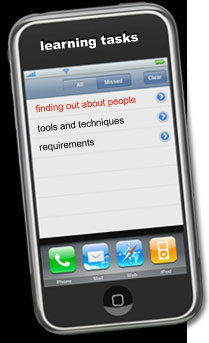
![]()
My first principle in design is to think first about the people part of the design: Who are the users? What do they want from the experience? What will give satisfaction and enjoyment?
(Moggridge, 2007. p. 665)
User research should occur before any design or development work begins. The outcome of user research is documentation that describes users, their needs and goals. This helps develop the requirements for your project
So what strategies can you use to find out?
NOTE: This task is designed for a couple of your group to do.
IDEO have developed a set of fifty one cards that their staff uses in design projects to find out about the people for whom their project is intended.
Saffer (2006) notes that essentially the design research process has three phases: you go to them; you talk to them, you write stuff down. A couple more steps refines the efficiency of this approach.

